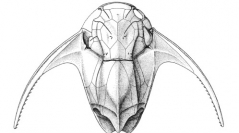

 Geodiversitas
38 (1) - Pages 5-20
Geodiversitas
38 (1) - Pages 5-20Spitsbergen shows a several kilometers thick, mostly siliciclastic Devonian sequence. In this sequence, the Wood Bay Formation represents a typical Old Red Sandstone megafacies unit of Early Devonian age (Pragian-Emsian). It outcrops in the Andrée Land Block (often wrongly designated as the “main Devonian graben”) in NW Spitsbergen. Its stratigraphy has been mostly established in two areas of this block, that is, in the Woodfjorden area in the north, and in the Dicksonfjorden-Austfjorden area in the south. A revision of the pteraspidiform heterostracan vertebrates has been carried out in both areas. Eight different fossil assemblages are defined, five for the Woodfjorden area (WA), and three for the Dicksonfjorden-Austfjorden area (DAA), that enable the correlation of the Sigurdfjellet and Kapp Kjeldsen “faunal divisions” of the lower Wood Bay Formation (in WA) with the Austfjorden Member (in DAA), and the Keltiefjellet “faunal division” of the upper Wood Bay Formation (in WA) with the Dicksonfjorden Member (in DAA). Unfortunately, pteraspids do not help with correlation between the uppermost parts of the Wood Bay Formation in the north and south of the Andrée Land Block. These results are used also for a more precise correlation with the heterostracan-bearing, Early Devonian, Old Red Sandstone series of Novaya Zemlya and Severnaya Zemlya in the Russian Arctic. They also confirm that Spitsbergen and those Russian archipelagos were elements of the Early Devonian, palaeobiogeographic Arctic Province.
Old Red Sandstones, Pragian-Emsian, Heterostraci, vertebrates, Svalbard, Novaya Zemlya, Severnaya Zemlya